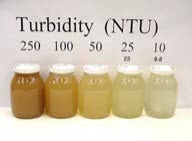Updates
|
- Spring 2002 – HBC “911” Emergency Response – fish biologists report declining trend in adult HBC, the finding results in AMWG’s humpback chub ad hoc committee and consideration of a dozen experimental “management strategies” intended to arrest the decline and conserve humpback chub - one of which is to determine feasibility of importing “fine-sediment” from Lake Powell source areas to the CRe, near the Paria River confluence w/ the Colorado River = turbidity cover for native fish when Paria does not contribute enough fines to meet a “200 FNU” condition in the main channel of Marble / Eastern Grand Canyons.
- 2004-5 – Mechanical Removal project reports abrupt decline in rainbow trout throughout Marble and Grand Canyons at start of Year-3 MR treatment, and this step-change (shown in Coggins et al, 2011, Fig 7, p. 468) coincides with long string of Paria and LCR floods / sediment inputs that occurred from mid-September 2004 through January 2005; including the largest winter Paria River flood in January 2005, since December 1966.
- 2007 – Sediment Augmentation - Randle et al. (2007) deliver final technical feasibility report to AMWG, which declares that sources of fine sediment from the delta of Navajo Creek within Lake Powell could, in fact, be transported around Glen Canyon Dam & delivered to the CRe to manage turbidity of Marble and eastern Grand Canyons, but at a cost ranging from $150 (silt/clay only) – 400 (silt/clay/sand) million w/ annual maintenance of ~$9 million if an extra 1 Tg of sand were also to be augmented for sandbars as well. (estimated costs provide a means to value Paria River sediment provided as “ecosystem service” compliments of Mother Nature.
- Fall 2010 – Non-Native Trout Control EA / SDM Workshop – fish experts identify 19 options for controlling trout below Lees Ferry, with concept of “turbidity curtain” being rated the most effective long-term strategy (see Runge et al., 2011, p. 29, Table 3, hybrid option E [Sediment curtain (single strategies: 3b, 5e, 6, 13): #13 is long-term strategy to emigration; #5 is the short-term strategy to emigration while infrastructure is being built; #3 is needed in short-term to reduce extant RBT population. Assumptions: RBT and BNT limit HBC recovery, Lees Ferry is the source of RBT, removal @ PBR or sediment curtain])
|
|
Links
|
|
|
Projects
|
|
|
Presentations and Papers
|
|
2018
2016
1995
|
Other Stuff
|
|
Question: What is the difference between the turbidity units NTU, FNU, FTU, and FAU? What is a JTU?
Summary: Turbidity units NTU, FNU, FTU, FAU, and JTU
Answer:
- NTU stands for Nephelometric Turbidity Unit and signifies that the instrument is measuring scattered light from the sample at a 90-degree angle from the incident light.
- FNU stands for Formazin Nephelometric Units and also signifies that the instrument is measuring scattered light from the sample at a 90-degree angle from the incident light. FNU is most often used when referencing the ISO 7027 (European) turbidity method.
- NTU is most often used when referencing the USEPA Method 180.1 or Standard Methods For the Examination of Water and Wastewater.
- When formazin was initially adopted as the primary reference standard for turbidity, units of FTU or Formazin Turbidity Units were used. These units, however, do not specify how the instrument measures the sample.
FAU or Formazin Attenuation Units signify that the instrument is measuring the decrease in transmitted light through the sample at an angle of 180 degrees to the incident light. This type of measurement is often made in a spectrophotometer or colorimeter and is not considered a valid turbidity measurement by most regulatory agencies.
A JTU or Jackson Turbidity Unit is a historical unit used when measurements were made visually using a Jackson Candle Turbidimeter. Water was poured into a tube until a flame underneath the tube could no longer be distinguished.
The turbidity units NTU, FNU, FTU, AND FAU are all based on calibrations using the same formazin primary standards. Therefore when a formazin standard is measured, the value for each of these units will be the same, however the value on samples may differ significantly.
|
|
